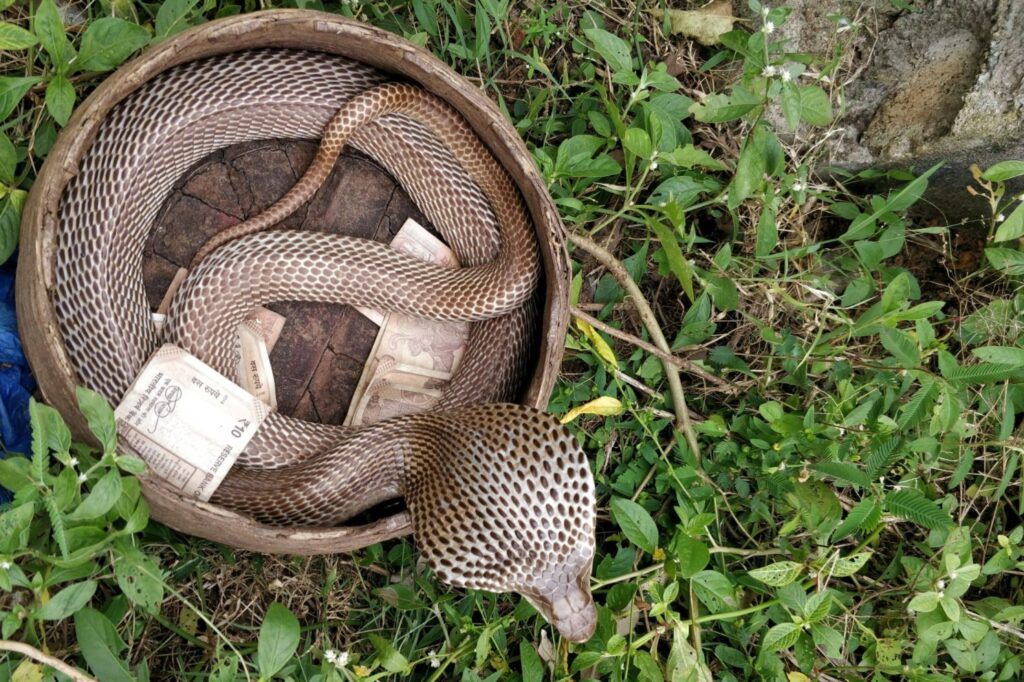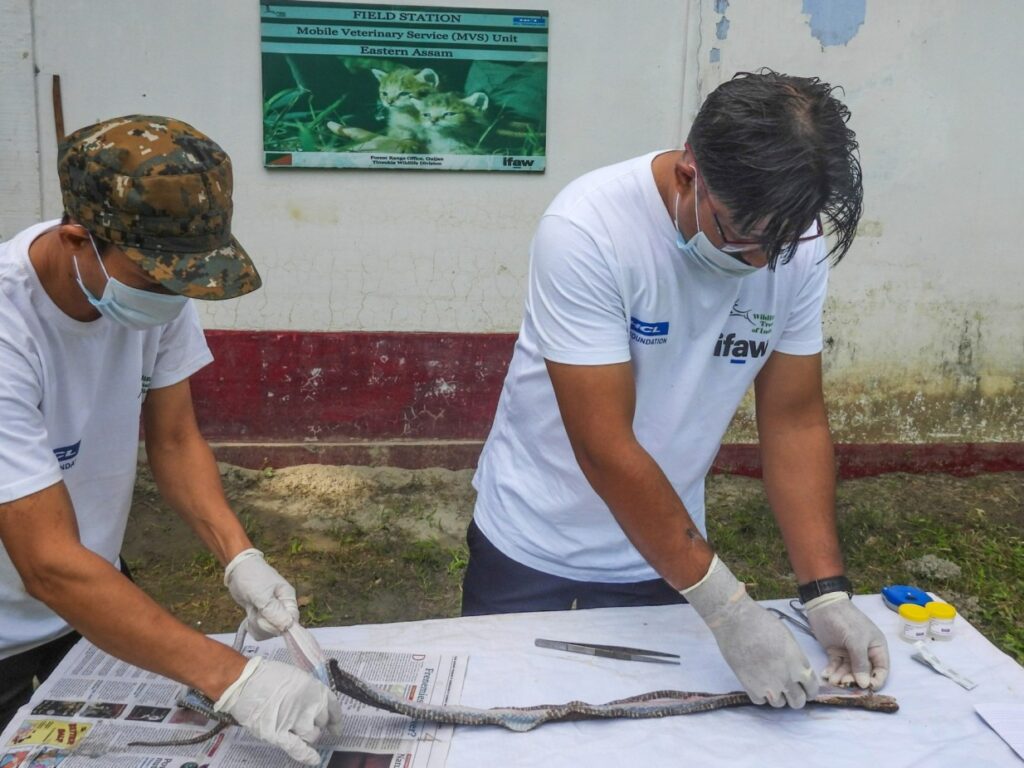A teenage boy caught me by surprise while I was humming away at a traffic light. He had a bamboo basket in one hand, hiding a snake, and the other hand outstretched towards me for alms. Laying out his palms for money, he pulled out a bamboo basket with his other hand. Evidently, he had a snake coiled inside. I asked him to open the lid and saw it feebly slither in an effort to hide from the overhead sun. Inside were notes, coins and flower petals, a vermillion smeared tattered photo of a deity, forming the only refuge from the bright afternoon sun. A classic case of snake charming.
Snakes, irrespective of being venomous or otherwise, face a grim fate across the country. Like most reptiles, they are the most misunderstood creatures. While on one hand, snakes are revered, on the other hand, it also takes a blink of an eye to see them pulped, especially in urban spaces overlooking the key ecological role they perform by keeping a check on the rodent population. This is an animal that, in the true sense – lives in two India’s.
Snake Charming – a banned practice that is still pursued at large
Most snakes are listed in the Wildlife (Protection) Act 1972, (WPA) including several common species like the cobras (all Indian species), Rat snakes, Russell’s viper, Checkered keelback, Olive keelback and the Dog-faced water snake. Therefore, it is illegal to capture any snake, let alone use it for commercial purposes. However, our fascination and beliefs about snakes, especially the cobras, have been so misguided, that snake charming remains a prevalent practice.

What is it like to be in the possession of a snake charmer?
Once a snake charmer captures a snake, the immediate treatment is the removal of fangs (in the case of venomous species like cobras). Using tweezers, the fangs are simply twisted and broken off to render the snake harmless. This is how the charmers would be able to show off the reptile in public without the risk of anyone being bitten. However, alongside losing its capacity to strike with venom, the reptile is also unable to feed. A snake in the wild will be able to go without food for weeks due to its slow metabolism. This very evolution of the snake to be able to conserve its energy for long has worked in favour of the snake charmers. A captured, starving and weak individual is on display, the kind of entertainment they encash for a living. The charmers would puncture and even burn the venom sacs to keep them from re-growing. Moreover, sometimes within a month, the snake dies of infection and starvation. A replacement for it is always waiting, as the show must go on.
A case study from Tinsukia, Assam
A few weeks ago, one such snake charmer was apprehended by the Assam Forest Department in Tinsukia. From him were recovered, two spectacled cobras, one sub-adult and another, a fully grown. Wildlife Trust of India’s (WTI) Dr. Khanin Changmai was handed over the reptiles for possible rehabilitation. The snakes were found to be highly dehydrated with the usual infection already set in.
“Even if the snakes recovered, we wouldn’t have been able to release it back in the wild”, exclaims the heartbroken veterinarian. Spectacled cobras aren’t endemic to the north-eastern region of India and releasing them would only mean introducing an invasive species. On investigating the snake charmer, it was revealed that the reptiles have travelled all the way from Central India, where this species in abundant. “It just wouldn’t have survived and even if it did, we would be breaking protocols by releasing. Other than euthanizing, the only option that remained was to send the reptiles to the zoo”, says Dr. Changmai.

Uprooting someone and putting them in captivity shouldn’t be the way of life. But even this remote option was only possible after the snakes would have recovered and regained their tools of feeding. Given time and proper veterinary care, snakes do grow back their broken fangs but this largely depends on the current status of their health. Till date, veterinary success with such snakes has been only a few. The ones that were admitted into WTI’s Eastern Assam MVS Rescue station too had an unsure future.
Dr. Khanin’s first priority was to be able to feed the snakes. While dehydration was easily taken care of, forcing food into the reptiles was risky, both for the handler and the reptile itself. Regurgitation would have been even more tasking for the already weak individuals. The only possible way to get some food inside the snakes was funneling in raw eggs, which cobras are known to predate on.
Things were looking up after two weeks when both snakes seemed to have started growing back their fangs. But, the happiness was short-lived as the older snake died on the 16th day after rescue. Dr. Khanin continued the treatment on the other individual. All this while, WTI has also been in talks with the Assam State Zoo for a possible adoption of the remaining individual, if it does survive past the process. But, after a month long ordeal, we lost the battle.
“In WTI’s rescue history, there have only been a few times that a snake seized from a snake charmer has been successfully sent back to the wild” says Dr. Khanin. The same is true for cases from across India. When snake charmers defang the reptile, they brutally also pluck the venom gland altogether. Only in a few cases, such as the above, that the snake is able to re-grow a fang. Consequently, any snake with a snake charmer is on a countdown to death. While the law is there, it is only through a collective consciousness; we can hope to bring about a change. The next time you see a snake charmer, think about these two individuals who fought hard but couldn’t make it.
Written By: Madhumay Mallik
Byline: Madhumay Mallik is passionate about photography, travel and documenting his exploits, not necessarily in that order. He is an enthusiastic member of the Communications team of Wildlife Trust of India, raring to travel and document stories from their field projects.
Help us Help Them! Think Wildlife Foundation is a non profit organization with various conservation initiatives. Our most prominent campaign is our Caring for Pari intiative. Pari is a rehabilitated elephant at the Wildlife SoS Hospital. 25% of the profits from our store are donated to the elephant hospital for Pari. Other than buying our wonderful merchandise, you could donate directly to our Caring For Pari fundraiser.
